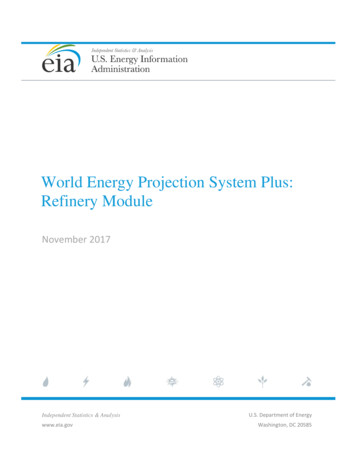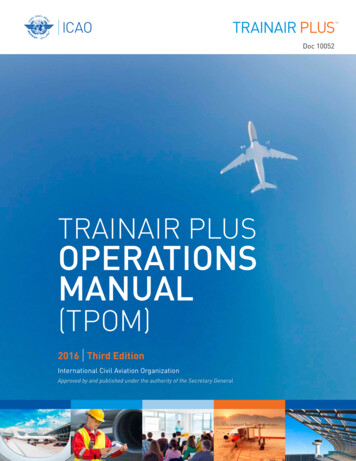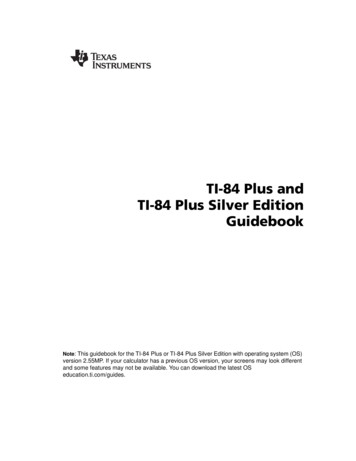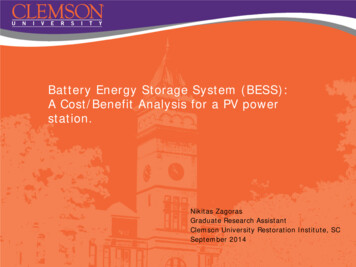
Transcription
World Energy Projection System Plus:Refinery ModuleNovember 2017Independent Statistics & Analysiswww.eia.govU.S. Department of EnergyWashington, DC 20585
November 2017This report was prepared by the U.S. Energy Information Administration (EIA), the statistical andanalytical agency within the U.S. Department of Energy. By law, EIA’s data, analyses, and forecasts areindependent of approval by any other officer or employee of the United States Government. The viewsin this report therefore should not be construed as representing those of the U.S. Department of Energyor other federal agencies.U.S. Energy Information Administration World Energy Projection System Plus Model Documentation 2016: Commercial Modeli
November 2017Contents1. Introduction . 3Purpose of this report . 3Model summary . 3Model archival citation . 3Model contact. 3Organization of this report . 32. Model Purpose . 1Model objectives . 1Model inputs and outputs . 2Relationship of the Refinery Model to the other WEPS Models . 43. Model Rationale . 7Theoretical approach . 7Fundamental assumptions . 7Key Assumptions. 94. Model Structure . 10Structural overview. 10Key Computations and Equations. 13Refined Product Wholesale and Retail Pricing – 16 WEPS regions . 14Alternative crude pricing . 17Appendix A. Input Data and Variable Descriptions . 19Appendix B. Subroutines Description . 25Appendix C. References . 27Appendix D. Model Abstract . 28Model acronym. 28Appendix E. Data Quality . 32Introduction . 32Source and Quality of Input Data . 32Source of Input Data . 32Data Quality Verification . 321U.S. Energy Information Administration / Refinery Model of the World Energy Project System Plus: Model Documentation
November 2017TablesTable 1. Refinery Model Inputs . 2Table 2. WEPS Model Outputs . 4Table 3. Heat Rates . 23FiguresFigure 1.Figure 2.Figure 3.Figure 4.Figure 5.World Energy Projection System Plus (WEPS ) Model Sequence . 5Relationship between the Refinery Model and Other WEPS Models. 6Long Term Persistence of Marginal Refining Configuration for a Given Global Refining Center . 8Example Refining Center Refined Product Determination – USGC . 10Example Refined Wholesale Product Price Determination for two of the 16 IEO Regions . 13U.S. Energy Information Administration / Refinery Model of the World Energy Project System Plus: Model Documentation2
November 20171. IntroductionPurpose of this reportThis report documents the objectives, analytical approach, and development of the World EnergyProjection System Plus (WEPS ) Refinery Model. It catalogues and describes the model assumptions;computational methodology; parameter estimation techniques; and model source code that are used togenerate projections in the reference and side cases, as well as other scenarios.The document serves three purposes. First, it is a reference document providing a detailed descriptionfor model analysts, users, and the public. Second, it meets the legal requirement of the U.S. EnergyInformation Administration (EIA) to provide adequate documentation in support of its models (PublicLaw 93-275, section 57.b.1). Third, it facilitates continuity in model development by providingdocumentation from which energy analysts can undertake model enhancements, data updates, andparameter refinements as future projects.Model summaryThe WEPS Refinery Model is a calculation tool. It uses the projected light, low sulfur crude oil price (aproxy for West Texas Intermediate—WTI—crude) and other input information to model global refinedproduct markets. The WEPS Refinery Model computes wholesale and retail refined product pricing inkey global refining centers and the 16 International Energy Outlook 2017 (IEO2017) regions (referred toas demand regions in this document).Model archival citationThis documentation refers to the WEPS Refinery Model.Model contactAdrian GeaglaU.S. Energy Information AdministrationU.S. Department of Energy1000 Independence Avenue, SWWashington, D.C. 20585Phone: (202) 586-2873Email: adrian.geagla@eia.govOrganization of this reportChapter 2 of this report, “Model Purpose,” identifies the analytical issues of the WEPS Refinery Model,and addresses the general types of activities and relationships it embodies, its primary inputs andoutputs, and its interactions with other WEPS modules. Chapter 3 describes in greater detail therationale behind the model design, the modeling approach, and the assumptions used in the modeldevelopment process, citing theoretical or empirical evidence to support those choices. Chapter 4details the model structure, model flows, and key computations.3U.S. Energy Information Administration / Refinery Model of the World Energy Project System Plus: Model Documentation
November 2017The Appendices to this report provide supporting documentation for the input data and parameter files.Appendix A lists and defines the input data used to generate parameter estimates and endogenousprojections, along with relevant outputs. Appendix B contains a mathematical description of thecomputational algorithms, including the complete set of model equations and variable transformations.Appendix C is a bibliography of reference materials used in the development process. Appendix Dprovides the model abstract. Appendix E discusses data quality and estimation methods.U.S. Energy Information Administration / Refinery Model of the World Energy Project System Plus: Model Documentation4
November 20172. Model PurposeModel objectivesUnderstanding the interactive effects of changes in U.S. and world energy markets has always been akey EIA focus. The Refinery Model was incorporated into WEPS in order to enhance the capabilities ofWEPS to address the interaction of the global and U.S. oil markets. The main objective of the RefineryModel is to further enhance the EIA’s long term price projection capabilities. The model is divided intotwo parts. Part 1 is a simple aggregation of liquids demands projections from the WEPS demand andtransformation models. Part 2 is used to calculate refined product prices based on crude oil pricesprovided by the Petroleum Model.Components of the WEPS Refinery Model accomplish the following: Refinery Model 1: Calculation of world crude demand delivered to refineries in order to meetthe aggregated product demand in the transportation, industrial, residential, commercial,electric power, and district heat sectors. The computed world crude demands are used bythe Petroleum Model.Refinery Model 2: Calculation of reasonable, long-term equilibrium-type refined productpricing for the three primary global refining centers: the U.S. Gulf Coast (USGC), NorthwestEurope (N.W.E.), and Singapore.The Refinery Model uses the projected WTI price at Cushing, Oklahoma as the basis formarker crude oil prices in the USGC, Brent projected crude prices in N.W.E., and Dubaiprojected crude prices in Singapore.oThe model also uses projected light to heavy product differentials and the expectedmarginal refining configuration in each of the three refining centers as bases for therespective refined product pricing calculations.oRefined product pricing guidelines for the three global refining centers have also beenestablished to ensure that relative product pricing among the three centers is inagreement with projected global trade patterns.Refinery Model 2: Calculation of refined product pricing for the 16 IEO2017 regions.The Refinery Model uses a set of global pricing guidelines which have been established torelate pricing in the three global refining centers to pricing in the demand regions.The set of global pricing guidelines is based on the projected transportation linkagesbetween the three global refining centers and each of the demand regions.The transportation costs used for these linkages are reasonable representations of therelative shipping costs between the refining centers and the demand regions.Refinery Model 2: Calculation of five crude type prices using the Alternative Crude Valuationmethod, which is based on the concept of indifference or parity pricing.In a perfect market, the price differential between two crude types should be very close tothe difference between their netbacks at the refinery that sets the price (marginal refinery).In a Global Refining Center, refiners can select from a variety of crudes to fill out theirmarginal refining capacity.1U.S. Energy Information Administration / Refinery Model of the World Energy Project System Plus: Model Documentation
November 2017 Refiners will typically pay more for light sweet crudes vs. heavy sour crudes since the lightsweet crudes yield a more highly valued product slate with less hydroprocessing than doheavy sour crudes.Model inputs and outputsBecause Refinery Model 1 is a simple aggregation of output from other WEPS components, theremainder of this documentation focuses on the computations performed in Refinery Model 2 and willrefer to it as “Refinery Model.”InputsThe primary inputs to the WEPS Refinery Model are as follows: For the calculation of refined product pricing for the three global refining centers, inputs include theprojected WTI price; the corresponding marker crude prices in the three global centers; the markercrude product yields in the marginal refining configuration for the three centers; the heavy fuel oilto crude oil discount, which sets the light to heavy refined product differential environment;expected variable and fixed refining operating costs; a capital recovery cost factor; light productpricing deltas to a primary light product (motor gasoline); and the liquefied-petroleum-gas (LPG)-tocrude-oil discount. For the calculation of wholesale refined product pricing in the demand regions, inputs include thetransportation cost differentials from the three global refining centers to the 16 regions. For the calculation of the retail refined product pricing in the demand regions, inputs include themultipliers that are used to compute retail product prices by sector based on the wholesale productprices.The major inputs are summarized in Table 1 with additional detail in Appendix A.Table 1. Refinery model inputsModel InputsSourceTo Determine Long Term, Equilibrium Pricing in the Three Global Refining CentersExpected WTI Market Crude priceExogenous values from WEPS Expected Corresponding Marker Crude prices in the threeDetermined in Refinery Model via adjustment constantsGlobal Refining Centersderived from linear regressions.Marker Crude yields in the appropriate Marginal RefiningConstants provided to the Refinery Model Source:ConfigurationRefinery2.xmlExpected Heavy Fuel Oil to Marker Crude discount for theConstants provided to the Refinery Model Source:three Global Refining CentersRefinery2.xmlExpected LPG to Marker Crude discount for the three GlobalConstants provided to the Refinery Model Source:Refining CentersRefinery2.xmlExpected Variable and Fixed Operating Costs and CapitalConstants provided to the Refinery Model Source:Recovery Factor for the three Global Refining CentersRefinery2.xmlU.S. Energy Information Administration / Refinery Model of the World Energy Project System Plus: Model Documentation2
November 2017Table 1. Refinery model inputs (cont.)Model InputsSourceLight Product Pricing Delta to the Primary Light ProductConstants provided to the Refinery Model Source:Refinery2.xmlHeat content for Refined Petroleum ProductsConstants provided to the Refinery Model Source:Refinery2.xmlMultipliers, by region and sector, used to compute retailConstants provided to the Refinery Model Source:prices for Refined Petroleum ProductsRefinery2.xmlTo Determine Long Term, Equilibrium Pricing in the demand RegionsTransportation Cost Differentials from three Global RefiningConstants provided to the Refinery Model Source:Centers to the 16 IEO Regions and between RegionsRefinery2.xmlTo Determine Long Term, Equilibrium Pricing for alternative crudes in the US Gulf Coast regionSulfur content for five crude types considered (%)Constants provided to the Refinery Model Source:Refinery2.xmlLiquefied Gases yields for five crude types considered (%)Constants provided to the Refinery Model Source:Refinery2.xmlMotor Gasoline/Naphta yields for five crude typesConstants provided to the Refinery Model Source:considered (%)Refinery2.xmlDistillate yields for five crude types considered (%)Constants provided to the Refinery Model Source:Refinery2.xmlResidual yields for five crude types considered (%)Constants provided to the Refinery Model Source:Refinery2.xmlIncremental High Sulfur Fuel Oil discount for five crude typesConstants provided to the Refinery Model Source:considered ( /% sulfur)Refinery2.xmlIncremental sulfur Marginal Operational Cost for five crudeConstants provided to the Refinery Model Source:types considered ( /% sulfur)Refinery2.xmlFixed Operational Cost for five crude types consideredConstants provided to the Refinery Model Source:( /BBL)Refinery2.xmlCapital Recovery Cost for five crude types consideredConstants provided to the Refinery Model Source:( /BBL)Refinery2.xmlTransportation Cost to US Gulf Coast Region for five crudeConstants provided to the Refinery Model Source:types considered ( /BBL)Refinery2.xmlHigh Sulfur Fuel Oil Demand for Medium Sulfur Heavy crudeConstants provided to the Refinery Model Source:type ( /BBL)Refinery2.xmlOutputsThe primary outputs of the WEPS Refinery Model are projected long-term, equilibrium-type refinedproduct prices for the three global refining centers and the demand regions. Table 2 summarizes theseoutputs.3U.S. Energy Information Administration / Refinery Model of the World Energy Project System Plus: Model Documentation
November 2017Table 2. WEPS Model OutputsModel OutputsDestinationComputed Wholesale Refined Product Prices for threeReportingGlobal Refining CentersComputed Wholesale Refined Product Prices for the 16ReportingWEPS RegionsComputed Retail Refined Product Prices for the 16 WEPS Demand, transformation, and supply modelsRegionsComputed Prices for five crude types for US Gulf CoastReportingregionRelationship of the Refinery Model to the other WEPS ModelsThe Refinery Model uses information from other WEPS components (Figure 1). It also providesinformation to and receives information from other WEPS components. The information it uses isprimarily the projected WTI crude price. The information it provides includes refined product pricing forthe three global refining centers and the demand regions. The Refinery Model focus is on theinternational oil and refined products markets.Through the system, the Refinery Model receives projected liquids consumption of fuel by end use, coalto-liquids production, gas-to-liquids production, and crude oil prices from the demand, transformation,and supply models of WEPS (Figure 2). In turn, the Refinery Model provides retail petroleum productliquids prices, through the system, back to the demand, transformation, and supply models.U.S. Energy Information Administration / Refinery Model of the World Energy Project System Plus: Model Documentation4
November 2017Figure 1. World Energy Projection System Plus (WEPS ) Model Sequence5U.S. Energy Information Administration / Refinery Model of the World Energy Project System Plus: Model Documentation
November 2017Figure 2. Relationship between the Refinery Model and Other WEPS emand-CTL supplyRefinery 1 ModelCoal Model-GTL supplyNatural Gas Model-Demand-DemandDistrict Heat ModelWorld ElectricityModel-Demand-Demand-petroleum product consumption by fuel(crude equivalent)Refinery 2 Model-petroleum product retail prices-Crude oil pricesby sector-petroleum product retail pricesby sectorPetroleum ModelRef2-Report.txtU.S. Energy Information Administration / Refinery Model of the World Energy Project System Plus: Model Documentation6
November 20173. Model RationaleTheoretical approachThe WEPS Refinery Model uses projected crude oil prices and other input information to model globalrefined product markets. The Refinery Model computes long-term, equilibrium refined product pricingin key global refining centers and the demand regions. The underlying logic and approach used in theRefinery Model acts to yield internally consistent price sets for both crude oil and refined products.Fundamental assumptionsThe WEPS Refinery Model uses the concept of light product price setting for a given refining centerbased on three fundamental pricing drivers: Marker Crude Oil PriceRefining Marginal, or Price Setting, ConfigurationLight-to-Heavy Refined Product Price DifferentialThis light product price setting concept is widely used in the global refining and marketing industry byoperating companies, industry consultants, and other market participants. The light product pricesetting concept uses the corresponding marker crude price as the netback value of petroleum products.These netback value of petroleum products is computed using the marker crude product yields, theheavy fuel oil to crude oil discount, liquefied-petroleum-gas (LPG)-to-crude-oil discount, and lightproduct pricing deltas to a primary light product (motor gasoline).For the marker crude oil price, the following crude oils are used for the three primary global refiningcenters: WTI- United States Gulf Coast (USGC) Brent- Northwest Europe (N.W.E.) Dubai- SingaporeThe WTI, Brent and Dubai crude oil prices are brought into the Refinery Model as input values.For the refinery types, the following configurations are used as the appropriate respective refining pricesetting modes: Catalytic CrackingUSGC, N.W.E. HydroskimmingSingaporeThe refining margin is the difference between the wholesale value of the refined products that therefinery produces and the value of the crude oil from which they were produced. The margin differs byrefining configuration. The refining configurations above were determined based on historical data andexpected future marginal capacity refining modes. In addition, the marginal refining configuration for agiven global refining center generally persists for an extended time period as seen in Figure 3 which7U.S. Energy Information Administration / Refinery Model of the World Energy Project System Plus: Model Documentation
November 2017shows Louisiana Light Crude (LLS) refining margins as an example. The persistence of low margins for atypical catalytic cracking refinery in the U.S. Gulf Coast supports validity of the marginal refineryapproach used in the Refinery Model. These marginal configurations act to set the refined product yieldpatterns for the respective crude oils in the three refining centers.Figure 3. Long Term Persistence of Marginal Refining Configuration for a Given Global Refining CenterSource: Purvin and Gertz (GPMO – Dec 09)For the light-to-heavy refined product differential, the expected long term equilibrium price differentialis projected to be relatively narrow. In other words, the differential is expected to be wide enough tosupport reasonable incremental refining margins, but not so wide as to reflect non-equilibriumdifferentials that are periodically seen in refining markets and which then promote additional bottomsupgrading refining capacity additions.For Alternative Crude Prices, the following five crude types are considered:1.2.3.4.5.Foreign Light Sulfur Light (FLL)Foreign Medium Sulfur Heavy (FMH)Foreign High Sulfur Light (FHL)Foreign High Sulfur Heavy (FHH)Foreign High Sulfur Very Heavy (FHV)U.S. Energy Information Administration / Refinery Model of the World Energy Project System Plus: Model Documentation8
November 2017Key AssumptionsThe key assumptions that enable use of the marginal refinery light product price setting model in theRefinery Model are as follows: Method adheres to basic, long-term commodity supply/demand concepts and typical refiningreality, including:oLiquids, normally functioning spot markets for crude oil and refined products, withtransportation-based links to other marketsoSufficient global refining capacity to meet refined product demandoRefiners acting in a rational, profit-maximizing manner, thereby processing crude oil upto the point of essentially zero margin operation Method does not attempt to predict pricing under short-term market dislocations that yieldextraordinary crude oil and/or refined product imbalances and non-equilibrium pricing Even with the presence of short-term market dislocations, the method is still valid for long-term,equilibrium pricing projections because market participants will act to address short-termdisturbancesoA seven-year horizon is currently used to reach equilibrium-type pricing. Thisassumption is based on the two waves of new refining capacity additions in India, Chinaand Middle East during this period.9U.S. Energy Information Administration / Refinery Model of the World Energy Project System Plus: Model Documentation
November 20174. Model StructureStructural overviewThe main purpose of the Refinery Model is to compute long-term, equilibrium refined product pricing inkey global refining centers and the demand regions. It uses the projected WTI crude oil price and otherinput information to model global refined product markets. The underlying logic and approach used inthe Refinery Model acts to yield internally consistent price sets for both crude oil and refined products.Refined product pricing – Three global refining centersThe Refinery Model first computes the long-term, equilibrium refined product pricing in the three GlobalRefining Centers: the USGC, North West Europe and Singapore. An example of the model’s structure andthe logic flow used to determine the refined product pricing in one of the Global Refining Centers—theU.S. Gulf Coast—is illustrated in Figure 4.Figure 4. Example Refining Center Refined Product Determination – USGCIn Step 1, the product yields for the marker crude in the marginal refining configuration are entered inthe Refinery Model. For this example, the USGC marker crude is WTI and the marginal refiningconfiguration is catalytic cracking. Refinery yield, expressed as a percentage, represents the percent of petroleum productsproduced from input of WTI crude oil into the specific USGC refinery type.U.S. Energy Information Administration / Refinery Model of the World Energy Project System Plus: Model Documentation10
November 2017 A catalytic cracking (cat cracking) refinery configuration is one in which the crude oil and itsintermediate products are processed through the following primary refinery processes in orderto produce final products:oAtmospheric and Vacuum Crude DistillationoReformingoCatalytic CrackingoAlkylationoHydrotreatingoFinal Product BlendingIn this example, the primary products areoLiquefied petroleum gas (LPG)oGasoline and NaphthaoDiesel and KeroseneoLow Sulfur Heavy Fuel OilIn Step 2, the marker crude price is entered. In the case of the USGC, this is the price for WTI at Cushing,Oklahoma.In Step 3, reasonable additional costs, on a barrel of crude oil basis, are added to the marker crude pricein order to arrive at the total cost, including Transportation cost from Cushing, Oklahoma to the USGC Marginal, or Variable, Operating Cost Fixed Operating Cost Long Term Capital Recovery FactoroThe capital recovery factor represents the relatively small overall return realized byrefining assets across time.oThe factor does not reflect the return for individual investments in specific upgradingcapacity that a given refiner may have made. Rather, the factor reflects the overallmodest returns refiners have realized from the entirety of their investments acrosstime.11U.S. Energy Information Administration / Refinery Model of the World Energy Project System Plus: Model Documentation
November 2017Once the necessary data has been imported, the Refinery Model sums up the marker crude price andthe refining costs to yield the total input cost to process a barrel of crude into refined products in themarginal, or price setting, configuration.In Step 4, the Refinery Model sets the total input cost equal to the total product value. This can be donebecause the marginal refining configuration is, in fact, the price setting configuration.In the price setting configuration, the total product value equals the total input cost, given a zero profitmargin above the variable, fixed, and capital return factors included in the input cost.In Step 5, the heavy fuel oil discount to crude is entered in the Refinery Model. This discount acts todefine the light to heavy product differential environment.In Step 6, the LPG discount to crude oil is entered. The relative product price differentials for GasOil/Diesel, Jet/Kero and Naphta to Gasoline are also entered. These are the final inputs to the RefineryModel.In Step 7, the Refinery Model solves for the Gasoline/Naphtha price and following that, theDiesel/Kerosene price.In Step 8, as a final confirmation step, the Refinery Model calculates the Light to Heavy ProductDifferential to ensure that it is in the expected range. The Light to Heavy Product Differential isprojected to be relatively narrow in the long term.The differential is expected to be wide enough to support reasonable incremental refining margins, butnot so wide as to reflect non-equilibrium differentials that are periodically seen in refining markets andwhich then promote additional bottoms upgrading refining capacity additions. Incremental operatingmargin is the increase or decrease of income from continuing operations before stock-basedcompensation, interest expense and income-tax expense between two periods, divided by the increaseor decrease in revenue over the same period.The Refinery Model projects the refined product pricing for the other two global refining centers,Singapore and North West Europe, using a methodology similar to that used for the U.S. Gulf Coast.Refined product pricing – 16 IEO regionsOnce the Refinery Model projects the refined product pricing for the USGC, N.W.E. and Singapo
Refinery Model 1: Calculation of world crude demand delivered to refineries in order to meet the aggregated product demand in the transportation, industrial, residential, commercial, electr










